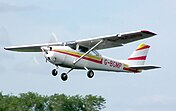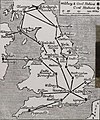Portal:Aviation
| Main page | Categories & Main topics |
|
Tasks and Projects |
The Aviation Portal

Aviation includes the activities surrounding mechanical flight and the aircraft industry. Aircraft includes fixed-wing and rotary-wing types, morphable wings, wing-less lifting bodies, as well as lighter-than-air craft such as hot air balloons and airships.
Aviation began in the 18th century with the development of the hot air balloon, an apparatus capable of atmospheric displacement through buoyancy. Some of the most significant advancements in aviation technology came with the controlled gliding flying of Otto Lilienthal in 1896; then a large step in significance came with the construction of the first powered airplane by the Wright brothers in the early 1900s. Since that time, aviation has been technologically revolutionized by the introduction of the jet which permitted a major form of transport throughout the world. (Full article...)
Selected article

Selected image

Did you know
...that during the Winter War, a Swedish fundraising drive paid for the purchase of a Fokker F.VIII airliner for the Finnish Air Force? ...that the Ryan X-13 Vertijet aircraft landed by using a hook on its nose to hang itself on a wire? ... that the loss of nine military crew members and passengers when Buffalo 461 was shot down over Syria in 1974, remains the largest single-incident loss of life in Canadian peacekeeping history?
General images -
In the news
- May 29: Austrian Airlines cancels Moscow-bound flight after Russia refuses a reroute outside Belarusian airspace
- August 8: Passenger flight crashes upon landing at Calicut airport in India
- June 4: Power firm helicopter strikes cables, crashes near Fairfield, California
- January 29: Former basketball player Kobe Bryant dies in helicopter crash, aged 41
- January 13: Iran admits downing Ukrainian jet, cites 'human error'
- January 10: Fire erupts in parking structure at Sola Airport, Norway
- October 27: US announces restrictions on flying to Cuba
- October 3: World War II era plane crashes in Connecticut, US, killing at least seven
- September 10: Nevada prop plane crash near Las Vegas leaves two dead, three injured
- August 6: French inventor Franky Zapata successfully crosses English Channel on jet-powered hoverboard
Related portals
Associated Wikimedia
The following Wikimedia Foundation sister projects provide more on this subject:
-
Commons
Free media repository -
Wikibooks
Free textbooks and manuals -
Wikidata
Free knowledge base -
Wikinews
Free-content news -
Wikiquote
Collection of quotations -
Wikisource
Free-content library -
Wikiversity
Free learning tools -
Wikivoyage
Free travel guide -
Wiktionary
Dictionary and thesaurus
Selected biography

The Reverend John Flynn (25 November 1880 – 5 May 1951) was an Australian Presbyterian minister and aviator who founded the Royal Flying Doctor Service, the world's first air ambulance.
Throughout his ministerial training, Flynn had worked in various then-remote areas through Victoria and South Australia. As well as tending to matters spiritual, Flynn quickly established the need for medical care for residents of the vast Australian outback, and established a number of bush hospitals. By 1917, Flynn was already considering the possibility of new technology, such as radio and the aeroplane, to assist in providing a more useful acute medical service, and then received a letter from an Australian pilot serving in World War I, Clifford Peel, who had heard of Flynn's speculations and outlined the capabilities and costs of then-available planes. Flynn turned his considerable fund-raising talents to the task of establishing a flying medical service.
The first flight of the Aerial Medical Service was in 1928 from Cloncurry. In 1934 the Australian Aerial Medical Service was formed, and gradually established a network of bases nationwide. Flynn remained the public face of the organisation (through name changes to its present form) and helped raise the funds that kept the service operating.
Selected Aircraft

The Airbus A340 is a long-range four-engined widebody commercial passenger airplane manufactured by Airbus. The latest variants (-600 & A340E) competed with Boeing's 777 series of aircraft on long-haul and ultra long-haul routes, but it has since been succeeded by the Airbus A350.
The A340-600 flies 380 passengers in a three-class cabin layout (419 in 2 class) over 7,500 nautical miles (13,900 km). It provides similar passenger capacity to a 747 but with twice the cargo volume, and at lower trip and seat costs.
The A340-600 is more than 10 m longer than a basic -300, making it the second longest airliner in the world, more than four meters longer than a Boeing 747-400.
- Span: 63.45 m (208 ft 2 in)
- Length: 75.30 m n(246 ft 11 in)
- Height: 17.30 m (56 ft 9 in)
- Engines: four 56,000 lbf (249 kN) thrust Rolls-Royce Trent 556 turbofans
- Cruising Speed: Mach 0.83 (885 km/h, 550 mph)
- First Flight: October 25, 1991
Today in Aviation
- 2010 – An Israeli Air Force F-16I crashes in Makhtesh Ramon while on a training over the Negev desert in southern Israel, killing both the pilot and navigator of the plane.
- 2010 – In the 2010 Karachi Beechcraft 1900 crash a JS Air charter crashes almost immediately after takeoff, killing all 19 passengers and 2 crew on board.
- 2009 – N120FB, a Grumman Albatross operated by Albatross Adventures, crashes shortly after take-off from St. Lucie County International Airport, Fort Pierce, Florida, after suffering an engine failure. The aircraft was damaged beyond economic repair.
- 2003 - British Airways Concorde G-BOAG became the last Concorde to leave JFK by air. She flew to Seattle Boeing Field and retired to Museum of Flight, Seattle.
- 1981 – First flight of the McDonnell Douglas AV-8B Harrier II
- 1979 – A Chinook helicopter of 450 Squadron successfully lifted a Lancaster aircraft from Gederich Ontario to Mount Hope, Ontario.
- 1959 – A small engine fire forces pilot Scott Crossfield to make an emergency landing on Rosamond Dry Lake, Edwards AFB, California, in North American X-15, 56-6671. Not designed to land with fuel on board, test craft comes down with a heavy load of propellants and breaks its back, grounding this particular X-15 for three months. Footage of this accident is later incorporated in The Outer Limits episode "The Premonition", first aired 9 January 1965.
- 1956 – F4U-7 Corsairs from the French aircraft carriers Arromanches and La Fayette bomb the aerodrome at Cairo. Israeli jets mistakenly attack the British sloop HMS Crane in the Gulf of Aqaba, and Crane shoots one down in self-defense.
- 1956 – The British and French bombing campaign against Egypt ends, with fixed-wing aircraft from the three British aircraft carriers alone having flown 1,300 sorties. Late in the day, the first British forces come ashore in Egypt as elements of the 3rd Battalion of the British Parachute Regiment land by parachute at El Gamil airfield and are reinforced by additional elements brought in by helicopter from the British aircraft carriers HMS Ocean and HMS Theseus.
- 1948 – A Boeing DB-17G Flying Fortress, 44-83678 returning to Eglin AFB, Florida from Fort Wayne, Indiana, crashes in woods SE of Auxiliary Field 2, Pierce Field, crashing and burning NE of the runway at Eglin main base early Friday. All five on board are KWF, including Lt. Col. Frederick W. Eley, 43, of Shalimar, Florida, staff judge advocate at Eglin for nearly three years - he was returning from his grandmother's funeral in Portland, Indiana; Maj. Bydie J. Nettles, 29, who lived in Shalimar, Florida but was originally from Pensacola, Florida, group adjutant for the 3203rd Maintenance and Supply section; Capt. Robert LeMar, 31, Ben's Lake, Eglin AFB, test pilot with the 3203rd; crew chief M/Sgt. Carl LeMieux, 31, of Milton, Florida; and Sgt. William E. Bazer, 36, assistant engineer, Destin, Florida. Bazer's wife was the Eglin base librarian.
- 1947 – First flight of the Scottish Aviation Pioneer
- 1944 – U. S. Army Air Forces Twentieth Air Force B-29 s based at Calcutta, India, begin occasional attacks on drydock and ship repair facilities at Singapore.
- 1944 – (5–6) U. S. Navy Task Force 38 carrier aircraft raid Japanese bases on Luzon. On the first day, SB2 C Helldiver dive bombers and TBM Avenger torpedo bombers from the aircraft carrier USS Lexington (CV-16) sink the Japanese heavy cruiser Nachi in Manila Bay, and U. S. Navy planes claim the destruction of 58 Japanese fighters over Clark and Mabalacat airfields. On the second day, a kamikaze damages Lexington. During the two days, U. S. Navy aircraft claim 439 Japanese aircraft destroyed, losing 25 U. S. aircraft in combat and 11 due to non-combat causes. The strikes cause a sharp reduction in Japanese air attacks on U. S. ships in Leyte Gulf.
- 1943 – 97 carrier aircraft from USS Saratoga (CV-3) and USS Princeton (CVL-23) carry out a destructive strike on a Japanese task force at Simpson Harbor, Rabaul, damaging the heavy cruisers Atago, Maya, Mogami, and Takao, the light cruisers Agano and Noshiro, and a destroyer for the loss of 10 aircraft. The U. S. Army Air Forces’ Fifth Air Force follows up with a strike by 27 B-24 Liberators escorted by 67 P-38 Lighntings on Rabaul town and its wharves. A counterstrike by 18 Japanese Nakajima B5 N (Allied reporting name “Kate”) torpedo bombers against the U. S. aircraft carriers mistakenly attacks a group of PT boats and a tank landing craft. The Japanese never risk heavy ships in the Solomon Islands again.
- 1940 – The U. S. Army Air Corps activates the Hawaiian Air Force, its first air force based outside the continental United States.
- 1938 – 5-7 – Non-stop flight by a pair of Vickers Wellesleys from Egypt to Darwin, Australia. This sets a new world distance record of 7,158 miles (11,520 km).
- 1934 – Pioneer Air Service aviator Col. Horace Meek Hickam, (1885–1934), dies when his Curtiss A-12 Shrike, 33-250, of the 60th Service Squadron, strikes an obstruction during night landing practice on the unlighted field at Fort Crockett, Texas, overturns. Hickam Field, Oahu, Hawaiian Islands, named for him 21 May 1935.
- 1921 – Curtiss test pilot Bert Acosta wins the Pulitzer Trophy in a Curtiss CR-2 and establishes a new closed-circuit airspeed record of 284.36 km/h (176.7 mph).
- 1917 - Jacqueline Auriol, a French Aviator, is born.
- 1911 – Calbraith Rodgers completes the first coast-to-coast airplane flight across the USA in the Vin Fiz Flyer – Taking 49 days, with several crashes en route.
- 1910 – The Willows airship N° 3 City of Cardiff arrives after the first dirigible flight across the English Channel, flying from London 10 hours and 30 min.
- 1909 – The United States Army Wright Military Flyer, serial 1, piloted by Lieutenant Frank P. Lahm with 2nd Lieutenant Frederick E. Humphreys as passenger crashes into the ground at College Park Airport, Maryland, while executing a sharp right turn. The aircraft had lost altitude due to engine misfiring and the aircrew had not taken account of their proximity to the ground when banking the aircraft to the right. Both officers were unhurt but the aircraft required repairs.
- 1908 – Wilbur Wright receives the Grand Gold Medal of the Aéro Club of France for advances in aviation.
References
- Shortcuts to this page: Portal:Airplanes • P:AVIA



















































